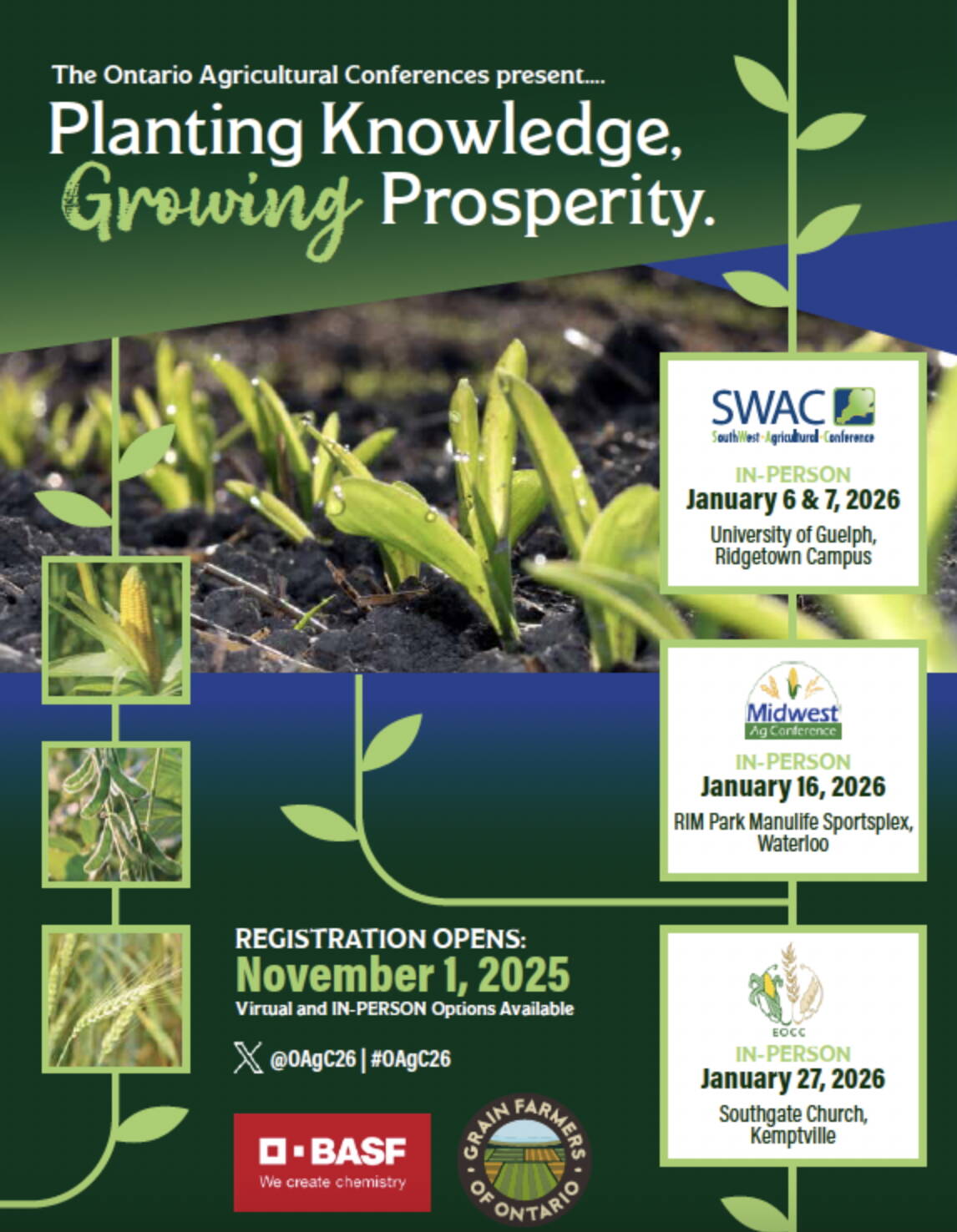Ontario corn, soybean and wheat prices have come under pressure in recent weeks. Export demand during the January through March period has been lower than expected for corn and soybeans. This has resulted in larger supplies for the domestic market.
Steady farmer selling has kept commercial stocks at higher levels. Canadian and U.S. flour millers have their nearby demand covered for soft red winter wheat. Limited domestic and export demand have resulted in lower prices.
Quick look
Soybeans: U.S. exports are down 20 per cent from year-ago levels.
Corn: South American corn is now the leader on the world market.
Wheat: Production problems are anticipated in the Middle East, China and Africa.
Read Also

Registration open for Ontario Agricultural Conference
The Ontario Agricultural Conference 2026 offers in-person and online access to expert insights, hands-on learning, and networking opportunities.
During February, Ontario experienced below normal precipitation, which has farmers concerned heading into the planting period. Ontario soybean acres for the 2024 growing season are expected to be slightly higher than last year while corn acres will be similar to year-ago levels.
Farmers are reluctant to make new crop sales given current conditions. This may be contributing to a stronger new crop basis for corn. The soybean basis for October and November remains relatively weak due to anticipation of larger acreage in Ontario and the U.S.
The Brazilian soybean harvest was 45 per cent complete as of March 3. Argentinean soybeans will start to move into export position at the end of March. Brazil’s Safrinha corn planting is moving into the final stages. At the time of writing this article, the Argentine corn harvest was in the early stages and will move into high gear by mid-March.
U.S. farmers are expected to decrease corn acres this spring while increasing soybean acres. The managed money has started buying in their record short position on corn, anticipating lower production estimates later in spring.
Russia continues to export wheat at break-neck speed. The European and Russian winter wheat crops had adequate snow cover over the winter. There is decent moisture for tiller development and secondary root system progression.
The U.S. Southern Plains have experienced drier conditions while the soft red winter wheat region is saturated. Western Canada has received above normal precipitation over the past month and North Dakota remains on the drier side.
Canadian GDP came in at one per cent for the final quarter of 2023 (quarter-over-quarter annualized rate), up from the contraction of 0.5 per cent during the third quarter. This compares to U.S. fourth quarter growth of 3.3 per cent. The Canadian dollar has been slowly depreciating against the U.S. greenback over the past month.
While the U.S. economy continues to outperform, Canada’s second and third largest trading partners (China and Europe) continue to struggle, resulting in lower demand for resources. Despite OPEC production cuts, larger production south of the border has curtailed demand for Canadian energy.
Soybeans
Canadian soybean exports from Jan. 1 through March 31 are projected to reach 550,000 tonnes. This is down from 826,000 tonnes for the same time frame in 2023. The lower export program has resulted in larger supplies for domestic usage. However, domestic crushers have been faced with lower product values, resulting in weaker crush margins.
The Canadian soybean crush pace appears to be lagging year-ago levels by 200,000 tonnes. Overall, the Ontario soybean market is contending with softer export demand and a year-over-year decline in the domestic crush. Ontario farmers typically deliver about 500,000 tonnes into the commercial system from Jan. 1 through March 31. This is sufficient to cover export and domestic demand.
Ontario farmers are expected to plant 3.05 million acres of soybeans this spring, up from the 2023 planted area of 2.913 million acres. Using a five-year average yield of 49.2 bu./acre, production has potential to reach 4.063 million tonnes, up from the 2023 output of 4.036 million tonnes.
At the time of writing this article in early March, Brazil soybeans were quoted at US$405/tonne f.o.b. Paranagua, unchanged from two weeks earlier. Argentine soybeans were quoted at $406/tonne, down US$20/tonne from mid-February. U.S. soybeans were valued at $448/tonne f.o.b. the Gulf, down $12/tonne from the previous issue. We’re seeing more competition from Argentina now that harvest is approaching. Ontario soybeans were valued at US$440/tonne f.o.b. St. Lawrence port.
China has been stepping forward more aggressively for Brazilian soybeans. U.S. soybean export sales are running 20 per cent below year-ago levels. World values for soymeal and soyoil are grinding lower as Argentina’s harvest approaches. This will eventually lower export demand for U.S. soymeal and soyoil. There are no changes to our production estimates.
Argentine soybean output is expected to reach 50 million tonnes, up from 25 million tonnes last year. We’ve lowered our Brazilian forecast from 156 million tonnes in our previous issue to 152 million tonnes. This is down 10 million tonnes from last year. Keep in mind the lower production will not curtail Brazil’s exports as its carryout remains burdensome.
U.S. farmers are expected to plant 87.5 million acres of soybeans this spring. Using an average yield of 51 bu./acre, production has potential to reach 120.8 million tonnes, up from the 2023 crop size of 113.4 million tonnes and up from the five-year average production of 113.8 million tonnes. Barring adverse weather, the market needs to encourage demand. By the time we move into fall, U.S. soybeans need to be discount to Brazilian origin.
What to do: We’ve advised farmers to be 80 per cent sold on their 2023 production and 20 per cent sold on new crop. We’ll save the final 20 per cent increment from 2023 until the upcoming U.S. crop is more certain.
Corn
Ontario corn exports move through a seasonal low during winter and then increase in spring and early summer. From Jan. 1 through March 31, Ontario corn exports will only reach about 150,000 tonnes. This increases to 1.5 million tonnes from April 1 through June 30. July and August are also typically slower months for export due to the Brazilian corn harvest and European winter wheat harvest. In Europe, nearly half of the winter wheat moves into feed channels, making it difficult for Ontario to export corn during summer.
As of Jan. 1, cattle on feed for slaughter in Ontario finishing operations totalled 1.541 million head, relatively unchanged from the Jan. 1, 2023 number of 1.557 million head. Total hogs in Ontario were 3.601 million as of Jan. 1, unchanged from Jan. 1, 2023. Domestic feed demand is running similar to year-ago levels. Therefore, domestic prices will be determined by world values and export movement later in spring.
At the time of writing, U.S. corn was offered at $187/tonne f.o.b. the Gulf, down $7/tonne from mid-February. Brazilian corn was offered at US$186/tonne f.o.b. Paranagua, down $11/tonne from two weeks earlier. Argentinean corn was offered at $184/tonne f.o.b., down $12/tonne from the previous issue.
South American corn has taken over as leader on the world market. French corn was offered at US$200/tonne f.o.b. La Pallice. Ontario corn was quoted at US$176/tonne f.o.b. St. Lawrence port. Ontario corn is competitive with French origin into Northern European feed markets. This should provide a solid floor for Ontario corn prices.
Brazil’s first crop corn harvest is in the final stages, while the Argentine corn harvest will occur in March and April. Corn supplies from Brazil’s Safrinha production will only be in export position in the latter half of June. The U.S. will regain export dominance during May. Brazil’s second corn crop will be in the vulnerable pollination period.
Brazil’s total corn crop is estimated at 115 million tonnes, down from last year’s record of 137 million tonnes. Argentine output is forecasted to reach 55 million tonnes, up from 35 million tonnes last year. A year-over-year decrease of five per cent is forecasted for U.S. corn acres. We’re expecting U.S. corn production to finish near 363 million tonnes, down from the 2023 crop size of 390 million tonnes and down from the five-year average of 365 million tonnes.
We’re expecting Ontario farmers to plant the same amount of corn as last year. Using a five-year average yield, Ontario corn production would finish near 9.5 million tonnes, down from the 2023 output of 9.6 million tonnes.
What to do: This week, we’re advising farmers to sell another 10 per cent of their 2023 production, bringing total sales to 60 per cent. We’re looking for a spring rally after the South American harvest pressure. The market will be extremely sensitive to weather developments due to the lower acreage. We all remember the major rally last June and we could see a similar pattern if there is an extended dry spell.
Wheat
During the first week of March, Russian wheat with 11.5 per cent protein was offered at US$203/tonne f.o.b. the Black Sea. French soft wheat was quoted at $210/tonne f.o.b. Rouen while U.S. soft red winter was trading at $244/tonne f.o.b. the Gulf. U.S. hard red winter was valued at $274/tonne f.o.b. the Gulf. Ontario soft red winter was valued at US$230/tonne f.o.b. St. Lawrence port.
Russian wheat continues to limit the upside on the world wheat market and has been trading into traditional homes for Canadian and U.S. wheat. Russian wheat exports for 2023-24 are estimated at 51 million tonnes, up from 50 million tonnes last year.
At this stage, traders are anticipating a crop near 91 million tonnes, which would be the third bumper crop in a row. The weather outlook for Southern Russia has potential to become drier from April 15 through May 15. If drier conditions materialize, the market could have potential to jump quite sharply.
The longer term forecast for the U.S. Southern Plains has turned drier for April and May. For the week ending Feb. 26, the Kansas wheat crop was rated 57 per cent good to excellent but there are concerns. The French and German crops appear to have favourable forecasts, which comes on the heels of optimal weather over the winter.
The longer term forecasts for China’s winter wheat region call for below normal precipitation. El Nino has resulted in above normal winterkill or abandonment in China. There are concerns about the size of China’s upcoming crop.
There are also production problems brewing in the Middle East, namely Iran and Turkey. North Africa remains on the drier side and the trend in weather calls for below normal precipitation and above normal temperatures. We’re also expecting a year-over-year decrease in India’s production.
The Ontario winter wheat crop is expected to finish near two million tonnes, down from the 2023 crop of 2.7 million tonnes. We expect domestic millers to show a stronger basis for new crop positions as the market will have to ration demand away from export channels. Given the lower production, the market cannot afford a crop problem on yield or quality.
What to do: This week, we’re advising farmers to sell 10 per cent of their 2023 production, bringing total sales to 70 per cent. We’re planning on making our next sale in late March or early April.
There is no risk premium in the market if adverse weather develops in Russia. The longer-term weather forecast for the U.S. southern Plains may result in production rally later in spring. The major importers of the world are facing lower production prospects. If Russia has a crop problem, the wheat market will be up sharply.















